While the crowds flock to Venice, Adrian Mourby finds a much more relaxing way of life on the Lido, where tourists of the past would stay and spend much of their time, away from the stifling air of the city…
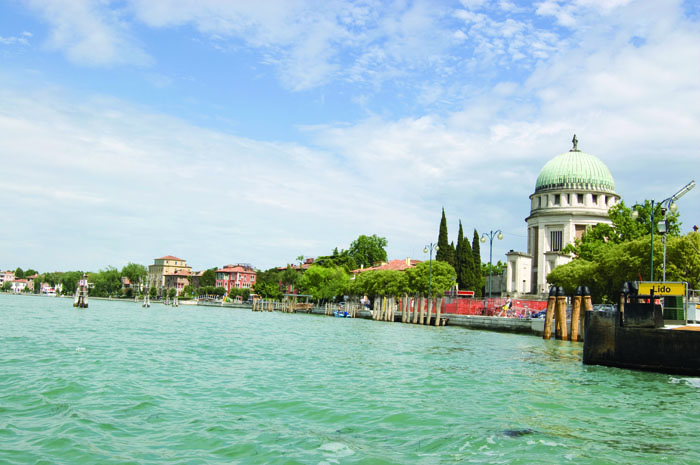
You can hear the silence of the Adriatic from up here. It doesn’t so much lap the shores of Lido di Venezia as kiss the sand and withdraw. This morning I woke up very, very early in the Excelsior Hotel. I’d flown in from Boston last night and at 6am I’m aware that my bodyclock is still on Massachusetts time. Unable to sleep, I open the shutters on a scene of almost complete silence. The Adriatic is hardly moving in the grey light of dawn while five floors below six men in shorts are silently raking the beach.
Lido is an odd place, an Art Nouveau (or Liberty-style) island that guards the lagoon on which Venice sits. In the 19th century visitors would stay here, where there was sea-bathing and a complete lack of pestilence. They might visit Venice in the afternoon for the churches or in the evening for the casino, but their days, and their nights, were spent on the calm, affluent shores of Lido.
The cabana with its deckchairs and tables – and waiter service across the hot afternoon sand – was an essential accessory for a holiday in Venice right up until the 1930s. Down below I can see the staff of the Excelsior opening up the scores of cabanas for which guests will pay a daily rental of €90 to €120 depending on proximity to the hotel and the quality of sea view.
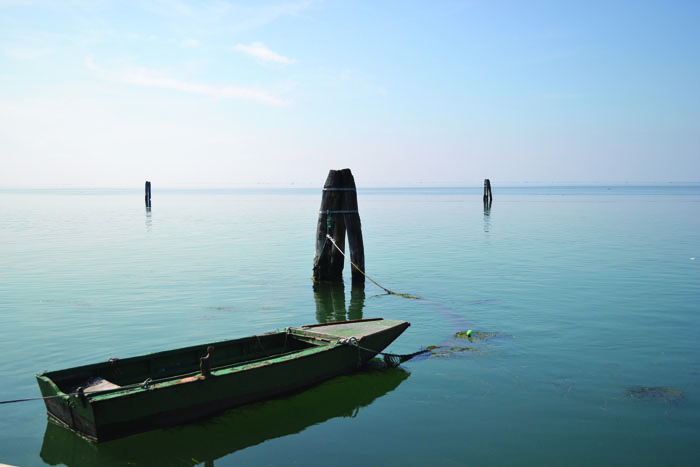
My journey from Boston yesterday was nightmarish. Changing planes at Heathrow I found there was an air traffic controllers’ strike that held me up several hours and in Milan where I was supposed to board a train to Venice, there was a taxi strike. But somehow I made it to Piazza San Marco five minutes before the last hotel shuttle left. The voyage across the lagoon was serene and at the Excelsior’s jetty, at the end of a long leafy canal, I was assured that they had already prepared room service. I had texted ahead and asked for what I genuinely believe to be the best seafood carpaccio in Italy. It didn’t disappoint.
And now I have a day on Lido before I get to check of progress with the hotel’s new Presidential Suite. Anyone who knows the extraordinary profile of the Excelsior will be familiar with its magnificent dome, which has been a hollow, theatrical shell since the great Giovanni Sardi designed the hotel in 1908. This year and last a new duplex presidential suite has been under construction within that dome, the biggest suite in Venice. It will be reserved every year reserved for the top stars of Venice’s film festival, an event that started at the Excelsior and still occurs every September on Lido.
I’ve come here to see how work is progressing but that won’t be until this afternoon at the earliest, so I have a long morning to fill.
I have a pre-breakfast swim, if you can call it that. The beach slopes down so gracefully that you need a lot of patience to walk out far enough to get even your knees wet. Now, as in the 1920s, Lido is more about cutting a bella figura on the beach than watersports. The Excelsior has an outdoor pool for those who really want to swim rather than just have a paddle and a pose.
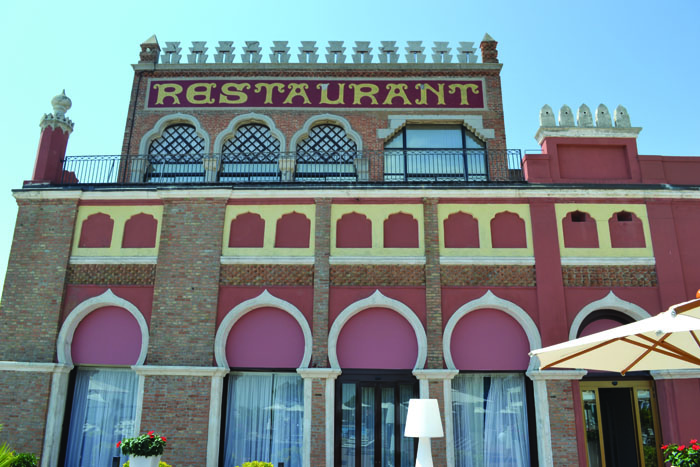
My breakfast is conducted surrounded by waiters. Afterwards I borrow a hotel bike to explore the island. Lido is rather neglected these days, like some great-aunt our parents used to visit. We know she is there but the photo-ops of San Marco are more alluring. Time to get properly acquainted.
I head north past the convention centre which every September becomes Palazzo del Cinema for the Venice Film Festival. It was built for the fifth festival in 1937 and has a modernist Mussolini touch. The first festivals were actually held in the Excelsior’s 600-seat cinema but the Palazzo can offer three venues, including a 1,100-seat main cinema from 1953 and, of course, a red carpet. As, Federico Fellini once remarked, “For a film director, entering the Palazzo del Cinema at the Venice Film Festival is like passing a final exam.”
Sooner than I expect – in fact only 500 metres north along Lungomare Marconi – I come upon Hotel des Bains where that quintessential Lido film, Death in Venice, was set, written, and partially filmed. What a shame it’s all boarded up at the moment. I hadn’t realised that you have to cross the road to get to the hotel’s beach. When Dirk Bogarde as Von Aschenbach looks wistfully out of his window towards the beach, Lungomare Marconi is just below him, out of shot.
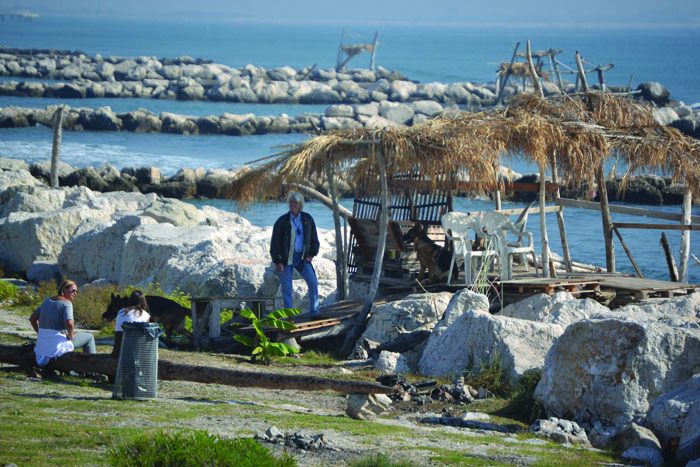
Turning inland, I find myself in a Liberty-style suburb full of tall old houses and slim hotels. At Caffè Tila I stop for a great espresso served by a lovely 85-year-old Venetian lady called ‘Cina. The coffee is perfect and the small garden comfortable but what’s remarkable is the photograph on display of her famous father in the cafe from the 1930s. Behind him is a picture of Mussolini. When she catches me checking this out, ‘Cina explains, “In those days you had to.”
Buzzed up on caffeine I’m keen to start pedalling properly. In 2009 cyclists competing in the Giro d’Italia charged down Via Sandro Gallo at speeds of 60 kmh – three times what I’m clocking up so far. But before I get to that long road that gazes back over the lagoon to Venice, I come across the glorious Grande Albergo Ausonia & Hungaria. This hotel is the absolute of Liberty-style Its huge multi-coloured facade is a mosaic masterpiece and the biggest in Italy, if not Europe. It was created for the newly-opened Hungaria over three years (1913-1916) by the famous ceramicist and sculptor, Luigi Fabris from Bassano del Grappa. This hotel is proof of the affluence of Lido at the beginning of the 20th century. The owners also commissioned the celebrated Milan designer, Eugenio Quarti for its furniture, which was shown at the Salone dell’Arte in Paris before being shipped to Venice. Closed during the First World War, the Hungaria reopened in 1920 and its nightclub, Follies Dancing, became a focal point of the Lido’s racy, golden age.
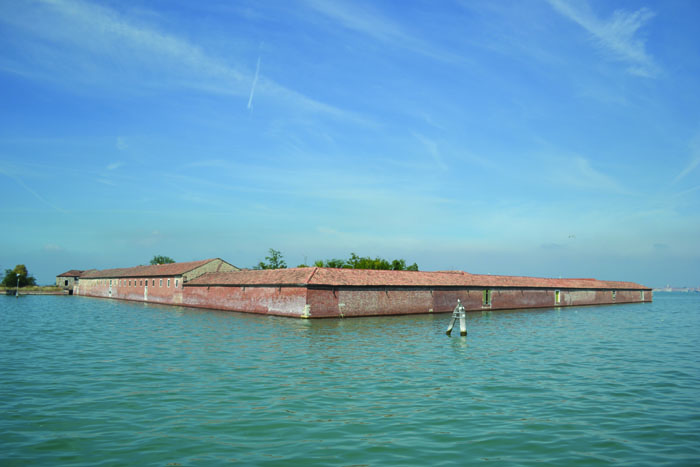
Putting my camera away, I aim for a sprint down the gracious tree-lined sweep of Lido’s Art Nouveau’s avenues. I bomb down Via Sandro Gallo and then Via Malamocca with the lagoon flashing by on my right, ineffably calm. Today it’s like a large piece of a grey-green glass, dotted with little brick hospital islands that used to serve as artillery platforms in the days when the Austro-Hungarian Empire owned Venice. Just a lone dredger on its way to work breaks the calm of the water.
At Malamocco I turn to the left and enter a small medieval town square. After all that Liberty style this is a complete surprise. Malamocco is where the Venice we know and love began during the reign of Theodatus, the second doge (742-755 AD). Theodatus it was who moved the ducal seat from Eraclea to this low spit of land now known as Lido. It’s remarkable to think that the nascent Venetian empire was run from this little moated city facing into the lagoon until 812, when it decamped to Rialto.
There’s a parish church here dedicated to Santa Maria Assunta that dates from the 12th century, and a 15th-century Palazzo del Podestà that displays the Lion of St Mark.
I check out the inevitable plaques to Garibaldi and Vittorio Emanuele II and say hello to a small dog whose owner is sitting out on the tiniest “Piazza Maggiore” I have ever seen, then it’s on to Porto degli Alberoni, the actual entrance to the lagoon, four kilometres south.
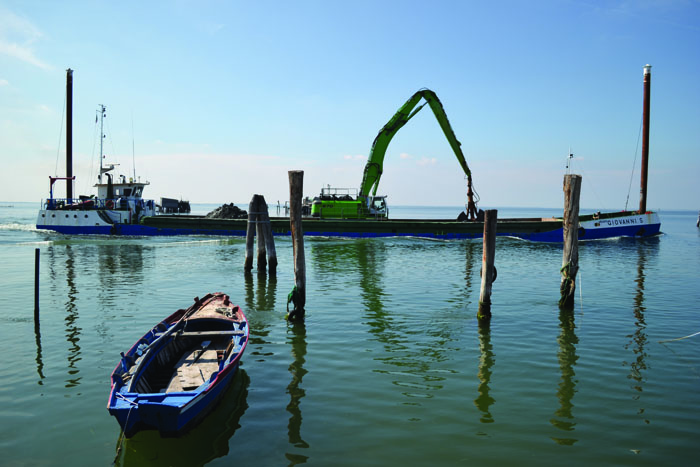
The village of Alberoni was named after its alberi, trees that local fishermen could see from the Adriatic and so know their way home. They used them to navigate themselves back towards the lagoon. Alberoni has a few cafés and a ferry terminal if you want to island-hop your way to the mainland.
Now I turn round and cycle up the Adriatic side of Lido, alongside a crudely-hewn sea wall. It’s clear from the big white rocks piled on this side of the island what a job Lido does in keeping rough seas out of the lagoon. There are little beaches scattered here and there between the rocks with informal shelters made out of driftwood. They get more salubrious the further north you head, but it’s clear this is where the locals swim for free while we’re paying €120 a day for a cabana on the Excelsior’s perfect beach. This is not bella figura territory.
By lunchtime I’m back at the Excelsior and wander into the hotel bar with its photos of movie stars who attended the film festival in the 1950s. There’s Kirk Douglas with his Van Gogh beard, there’s Ingrid Bergman with Roberto Rossellini, and a moustachioed Orson Welles photographed while pretending to write something. There’s also a jolly snap of early paparazzi (from the days before the term was coined). They are sitting on deckchairs in their suits with big happy smiles.
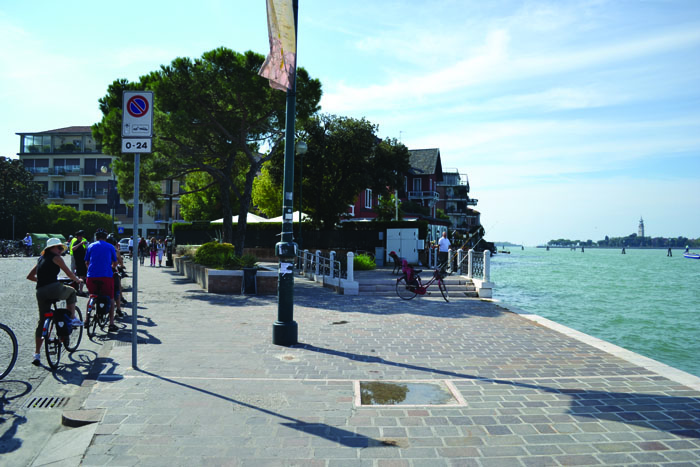
Head barman Antonio Micelotta is setting up the bar in his white jacket and happy to talk. He’s been in the business for 30 years now and tells me that drinking trends have changed a lot in Venice. Who has drinks before lunch these days? How did a simple drink like Prosecco become so popular around the world? Who has been his favourite customer?, I ask. Antonio is too tactful to tell me but he does relate the time that Al Pacino came in and ordered a San Pellegrino.
“He went outside to sit on the terrace by himself. The look in his eyes – it goes right inside you. I’ve served Robert de Niro and Robert Redford here but with Al Pacino there is this vibration.”
I wish I’d been there.
I go to check to see if the new Presidential Suite is ready to be viewed but the answer is still, “Not yet” and so I go back to my room to take in the sea view again. There are quite a few people on the beach now but it’s still very quiet down there. Lido di Venezia is a curious place, the relict of a previous golden age but a place where Al Pacino drinks San Pellegrino in the night, a Liberty-style suburb of Venice that has a medieval city hidden away at its core. And it’s certainly a very relaxing place to cool your heels.
I could take the hotel’s shuttle over to San Marco this afternoon but it’s bound to be crowded and to be honest, I quite fancy another seafood carpaccio. Maybe I’ll ask to eat in on the beach.
Photography © Kate Tadman-Mourby unless otherwise stated
